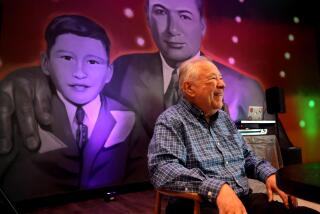Dreaming of a Box-Office Hit in ‘Selena’
CORPUS CHRISTI, Texas — Selena, the person, is now “Selena,” the movie.
Two years after the tejano superstar was slain in a Corpus Christi motel, her image reappeared before an adoring hometown crowd last Friday, one in a series of benefit premieres before the big-screen homage opens nationwide on Friday.
Braving an unseasonably cool south Texas night, more than 1,000 fans clustered outside Cinemark’s Tinseltown USA, while 500 others paid $100 each to watch the film with the cast and members of Selena’s family. Young girls clutched Selena dolls. A radio station hosted a Selena singing contest. Shrieks erupted at the sight of look-alike actress Jennifer Lopez, who called the event “a beautiful tribute to Selena’s life.”
It was also the latest burnishing of Selena’s legend, one that has grown increasingly mythical--and marketable--since her death.
Distributed by Warner Bros. and reportedly costing $20 million, “Selena” is being promoted as a validation of Latino clout in Hollywood and the crossover appeal of a genuine Mexican American star. To be a hit, like Selena’s posthumously released bilingual album, “Dreaming of You,” which debuted at No. 1 on the Billboard charts in July 1995, the movie will have to be both culturally authentic and universal--a balance that its makers are confident they have struck.
“I don’t think of it as a Hispanic film,” said director Gregory Nava, whose credits include “El Norte” and “My Family/Mi Familia,” both critically acclaimed accounts of Latinos reaching for the American Dream. “The story of Selena is a beautiful story and I’ve always been a believer that beautiful stories, well-told, are of interest to everybody.”
Yet the story that gets told in “Selena” remains a carefully tailored one, prepared under the scrutiny of the singer’s father and business manager, Abraham Quintanilla Jr., who is listed as an executive producer. Although it was Selena’s murder in 1995 that helped transform her into a folk hero for millions of Latinos--and bring the 23-year-old Grammy winner to the attention of an even wider audience--the film sticks mainly to her triumphant ascent from humble south Texas roots.
The subsequent trial and conviction of Yolanda Saldivar, 36, the former fan club president who shot Selena after being accused of embezzling funds, produced unflattering references to Quintanilla as a controlling “stage dad.” Recent books about Selena--some of which have bordered on the tabloidy and been roundly denounced by her family--have suggested that the singer was feeling lonely and conflicted about personal matters, including an unidentified “secret” allegedly known to Saldivar, in her final days.
As he walked a red carpet up to the Corpus Christi theater, Nava acknowledged that the film was conceived as “a celebration of life . . . not an exercise in investigative reporting.”
That premise initially gave him some misgivings about the project and later resulted in “a lot of disagreements” with the Quintanillas over the content and tone of certain scenes. The biggest battle, which Nava said he won, was to include Selena’s quickie marriage to Chris Perez, the guitar player in her band, despite her father’s insistence that she stay focused on her career.
“They finally saw the wisdom of using that--to show the way she really was, struggling for her own independence,” said Nava, adding that he wouldn’t have made the film if he had felt unduly censored.
Quintanilla and his wife, Marcella, walked into the screening with their heads down, not pausing to speak. But actor Edward James Olmos, who plays the Quintanilla patriarch, was effusive in his praise for the man and the film, which he called “truly the finest I’ve ever made.”
While watching it with his own mother the night before at the Los Angeles premiere, Olmos said that he “wept openly in ways that I’ve never wept at a film in my life.”
Although he conceded that he “would like to have dealt more in the situation” that caused Selena’s death, Olmos said that he accepted and respected the importance of making “a human film” with an inspirational, life-affirming message. “I’ve made ‘American Me,’ ” he explained, referring to his brutal and controversial depiction of Chicano prison gangs. “We don’t need another one.”
That notion seemed to please the people of Corpus Christi, a petroleum and resort town that has been dubbed the Latino Graceland--for the carloads of fans still coming to visit Selena’s house, her grave and the Days Inn where she was shot.
“I’m sure that down the road somebody will make a movie about all the bad things that people are saying about Selena’s life,” said Josie Suniga, 23, snuggling outside the theater with her 5-year-old daughter, Sonya. “But for now, I think it’s good to have a movie in her honor, even if it’s sugar-coated. Just look around. She’s an idol to all these kids.”
Janie Robles, 45, who had staked out a front-row spot behind the barricades with her 16-year-old daughter, Stephanie, noted that mainstream America doesn’t hesitate to cash in on its fallen stars, such as Elvis Presley and Marilyn Monroe.
She added that Latinos, especially when bombarded by so many other negative images, shouldn’t have any qualms about weaving myths of their own.
“We deserve something good, too,” Robles said.
*
* L.A. CELEBRATES ‘SELENA’: Producers, stars and fans remember singer at Cinerama Dome premiere. E3
More to Read
Only good movies
Get the Indie Focus newsletter, Mark Olsen's weekly guide to the world of cinema.
You may occasionally receive promotional content from the Los Angeles Times.









